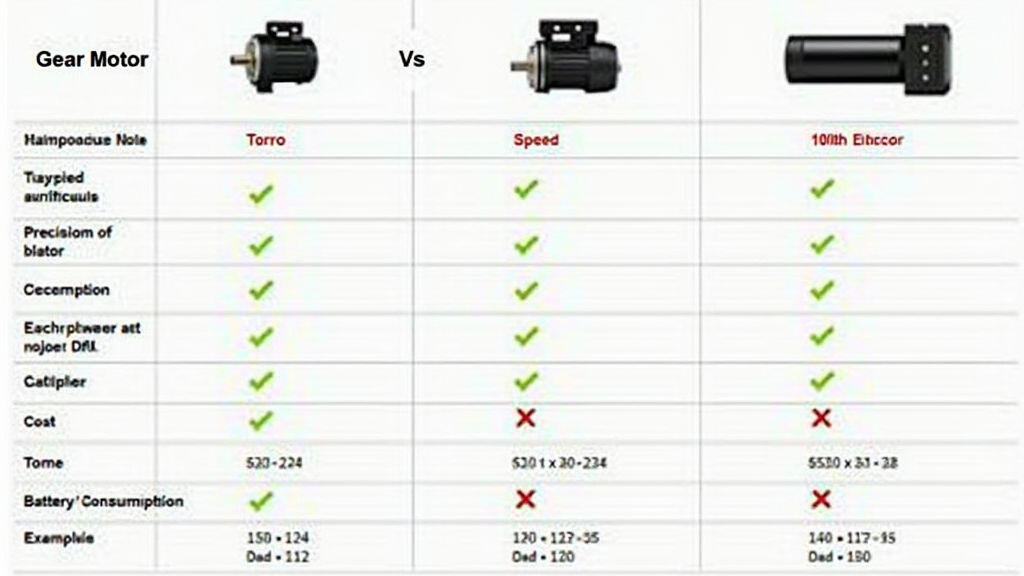
Agri‑tech is experiencing a rapid transformation, with smart farms, autonomous tractors, and precision irrigation systems becoming the new norm. Behind every high‑precision device lies a choice of motor—often a gear motor or a servo motor. Although both provide the mechanical power needed to drive agricultural equipment, their operating principles differ markedly. Understanding these differences is not a purely academic exercise; it directly influences power consumption, control complexity, maintenance needs, and ultimately the profitability of new farming machines. This article explores why distinguishing between gear and servo motors is essential for intelligent manufacturing in agriculture and how it shapes the future of farm technology.
Gear motors combine an electric motor with a gear train that reduces speed and increases torque. They are robust, inexpensive, and ideal for applications that demand steady, continuous motion—think of a tractor’s hydraulic pump or a seed planter’s feed auger. The simplicity of a gear motor means fewer parts that can fail, and it can operate effectively from low‑resolution position inputs.
Servo motors, on the other hand, are closed‑loop actuators that integrate a motor (typically a stepper or DC motor) with an encoder and a controller. This feedback loop allows the system to track position, speed, and torque in real time. Servo units are prized for fast, precise movements—such as the rapid steering adjustments on a robotic harvest assistant or the real‑time pitch control of a drone sprayer.

While both provide mechanical output, the freight capacity, resolution, and responsiveness to control signals differ. That difference is the bedrock of many intelligent manufacturing decisions in the agri‑tech sector.
Power Efficiency – Gear motors consume power proportionally to the load they deliver, but they cannot shut down precisely when idle. Servo motors, with their closed‑loop regulation, can maintain optimal output, delivering less power when the task demand decreases. In a large field processor, this distinction can translate into dozens of kilowatts saved annually.
Control Precision – Precision agriculture relies on centimeter‑level accuracy. Servo motors provide the incremental positioning needed to align seeders or perform delicate pruning tasks. Gear motors, by contrast, excel when the required movement is slow and stable, such as in a vertical lift system for a combine harvester's grain bin.
Maintenance Footprint – The mechanical simplicity of gear motors usually results in a longer service life with fewer moving parts. Servo motors, however, require periodic calibration of their encoders and protective shielding for the electronics. The design choice will influence both the initial purchase price and long‑term upgrade costs.

When engineers design a new autonomous harvester, the motor selection for each joint defines the machine’s capabilities. Mis‑matching a servo where a gear motor would suffice can inflate production costs; conversely, under‑specifying a gear motor for a task that demands quick response can reduce field productivity.
In a precision seed planter, the spouting mechanism must deposit seeds in a 2‑cm interval across a 5‑mile row. A servo motor’s controlling unit can adjust pitch and torque on the fly based on real‑time GPS feedback, ensuring optimal spacing. The gear motor could be reserved for the line‑feeding assembly, where the load is constant and speed variations are minimal.
Autonomous sprayers that navigate through a pest‑infested orchard use servo motors on their steering columns and pivot units. The ability to run corrective algorithms—such as adjustment for wind drift or sensor‑based yield mapping—relies heavily on the servo’s rapid updates. If a gear motor were employed instead, the system would lag behind the desired path, exposing crops to uneven pesticide exposure.
Large pharmaceutical‑grade grain dryers in a processing plant use a combination of both motor types. The honeycomb‑style griddles are driven by gear motors that provide consistent rotation for even drying. The temperature control fans are servo‑driven to precisely adjust airflow based on moisture‑sensing sensors, ensuring energy‑efficiency and product quality.

Smart farming bicycles are emerging around the world—autonomous harvester‑drones, vertical‑farm robots, and AI‑guided irrigators—as part of the 2024 Global Sustainable Agriculture Summit. These devices often incorporate modular motor architectures, offering both gear and servo options in a single chassis. This flexibility allows manufacturers to run testruns with low‑cost gear motors and replace them with high‑precision servos during field trials once the control logic is validated.
Another hot‑spot is the integration of digital twins for predictive maintenance. By streaming encoder data from servos into a cloud model, manufacturers can forecast when a motor will hit its performance baseline, pre‑emptively ordering parts. Gear motors, lacking such granular feedback, must rely on external vibration sensors or manual checks, which increases downtime.
The trend towards hybrid actuators—combining a gear reduction stage with a servo‑like control architecture—promises to deliver the best of both worlds. Companies are experimenting with integrated micro‑control boards that override the gear motor’s limitations, allowing direct positioning commands while leveraging the gear’s mechanical simplicity.
In the race to create intelligent, efficient, and sustainable agricultural machinery, the decision to employ a gear motor or a servo motor is more than a part‑selection trade‑off. It determines power usage, precision, service life, and the ability to adapt to future software upgrades. Farms that adopt this nuanced approach see measurable savings in fuel consumption, increased crop yields from more accurate planting, and reduced maintenance windows through better predictive diagnostics.
As the agri‑tech industry continues to integrate AI, cloud analytics, and robotic autonomy, the differentiation between gear and servo motors will only grow more critical. Manufacturers who sensibly couple the appropriate motor technology with context‑aware control systems are poised to lead the next wave of ecological and economic farm innovation.
Leave A Reply
Your email address will not be published. Required fiels are marked